External Resources in Georgia's Budget

When government expenditure exceeds revenues, the budget is in deficit. The source of deficit financing is debt, which can be obtained through domestic and/or external borrowing. Domestic debt, which is mainly denominated in local currency, is borrowed through treasury bills and government bonds. In contrast, external debt is taken in foreign currency from both multilateral creditors and individual foreign governments. In developing economy countries, the primary source of deficit financing is external borrowing, and accordingly, the share of debt denominated in foreign currency is high.
I. Government Debt
Georgia has consistently maintained a low fiscal deficit over the long term. Specifically, over the last decade, excluding the pandemic's effect, the consolidated budget deficit averaged 1.7% of the gross domestic product. The budget deficit, in its cumulative indicator, is reflected in government debt. Accordingly, the debt level is also low. Notably, over the last ten-year period, government debt relative to gross domestic product averaged 39.8% (excluding the pandemic effect).
Graph 1: Government Debt-to-GDP Ratio, %
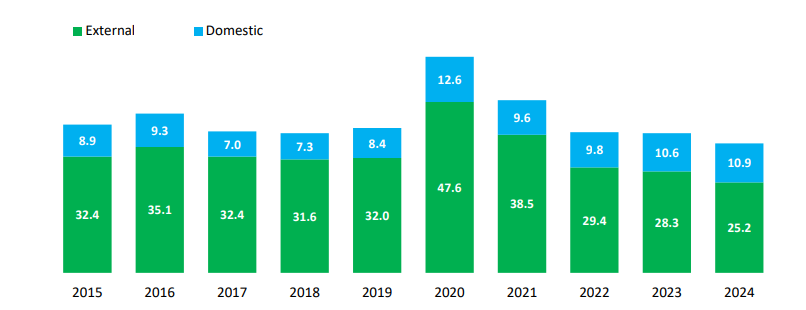
Source: Ministry of Finance of Georgia
The reason for Georgia's fiscal discipline is its constitutionally guaranteed fiscal rules. These rules, including a 3% ceiling for deficit and a 60% ceiling for debt, play a significant role in maintaining long-term fiscal stability.
Graph 2: Consolidated Budget Overall Balance as a Share of GDP, %
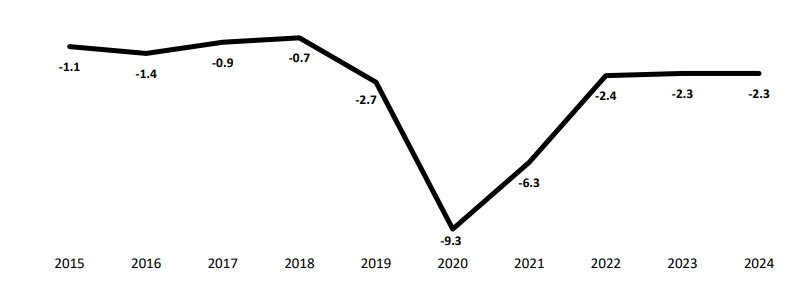
Source: Ministry of Finance of Georgia
Over the last decade, the average weighted interest rate on government debt was 3.5%, increasing to 4.9% in the post-war period. Given that constitutionally guaranteed fiscal rules exist in Georgia, the risk premium is lower, which was reflected in lower borrowing costs. However, Russia's war in Ukraine and the subsequent geopolitical situation increased risks.
Graph 3: Average Interest Rate on Loans, %
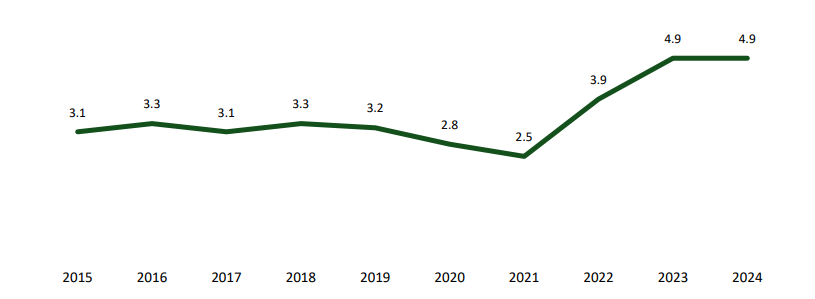
Source: Ministry of Finance of Georgia
As of the end of 2024, the total volume of public debt was 34.2 billion GEL, representing 36.1% of the country's gross domestic product. Of this, 10.9 percentage points comprise the contribution of domestic debt, which reached 10 billion GEL during this period. In total debt, domestic borrowed funds, whose primary source is treasury bonds with maturities of 1-5 years, account for less than one-third. It is worth noting that in recent years, the share of domestic debt in the government debt composition has increased, while external debt has decreased.
Graph 4: Government Debt at Year-End, GEL Million
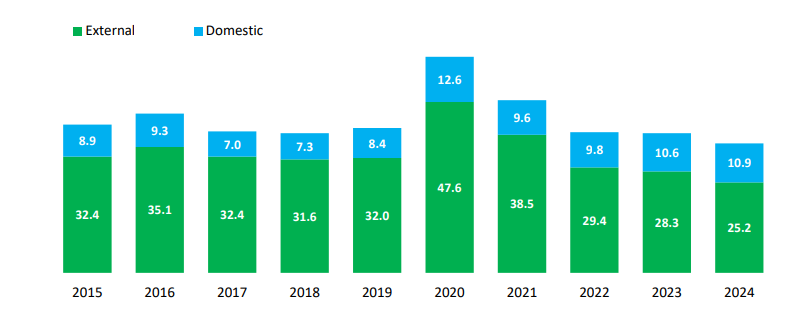
Source: Ministry of Finance of Georgia
The share of external debt in public debt exceeds two-thirds. At the end of 2024, the volume of external debt totaled 24.1 billion GEL, representing 25.2% of the country's gross domestic product. It should be noted that these indicators are reduced compared to previous years (the average of the last decade was 30.8%).
The majority of external debt, accounting for more than 75.9%, consists of loans received from multilateral international financial institutions. 6.1% of external debt represents resources obtained through securities, specifically eurobonds, while the remaining 18% is bilateral creditor debt. Among bilateral debtors, the largest creditors are France and Germany, whose shares in total external debt are 9.3% and 6.8% respectively.
Graph 5: Government Debt from Multilateral Creditors at Year-End, GEL Million
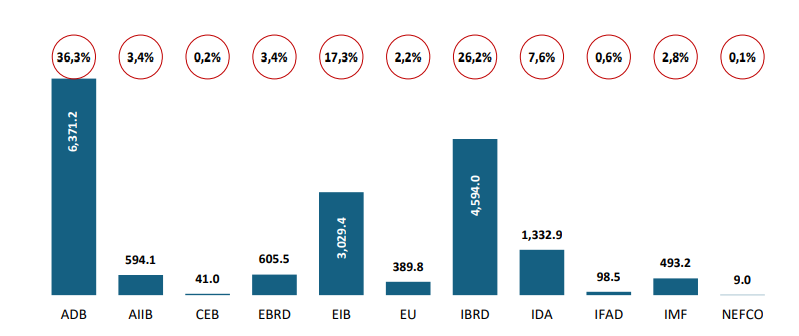
Source: Ministry of Finance of Georgia
As of the end of 2024, multilateral creditor debt was 17.6 billion GEL. The largest borrower among international financial organizations is the Asian Development Bank, whose existing loan obligation totaled 6.4 billion GEL at the end of 2024. Among multilateral creditors, the debt to the Asian Development Bank represents 36.3%. The Asian Development Bank's leading position among multilateral creditors lending to the Georgian government is related to the double crisis (2008-2009 - global financial crisis and war). During this period, a comprehensive loan framework agreement was concluded between the international financial institution and the Georgian government, aimed at promoting growth recovery, urban development, improving municipal services, and enhancing transport infrastructure. In subsequent years, the government received long-term loans under favorable conditions (mainly 1% interest rate) as a result of the framework agreement.
The second largest multilateral creditor is the International Bank for Reconstruction and Development, whose share in multilateral obligations is 26.2%. At the end of 2024, the Georgian government's debt to the International Bank for Reconstruction and Development was 4.6 billion GEL. The obligation to the bank stems from long-term and low-interest loans dating back to 2009, which were directed toward the development of national-scale road infrastructure. The European Investment Bank's share in loan obligations to multilateral creditors is 17.3%. At the end of 2024, the debt to the bank amounted to 3 billion GEL. The existing obligations to the bank are loans taken based on the framework agreement concluded in 2007, for the development of energy, water, and road infrastructure.
II. Loan Flows Over the Last Decade
Over the last decade, the European Investment Bank has been the largest multilateral creditor. Between 2015 and 2024, the Georgian government borrowed approximately 3,547.3 million GEL from this financial institution under 11 loan agreements. The funds borrowed from the bank were used for various infrastructure projects, with the majority allocated to the East-West highway. During this period, the European Investment Bank's share in the loan flows is 69%.
Graph 6: Total Loans Received from Multilateral Creditors in 2015-2024, GEL Million
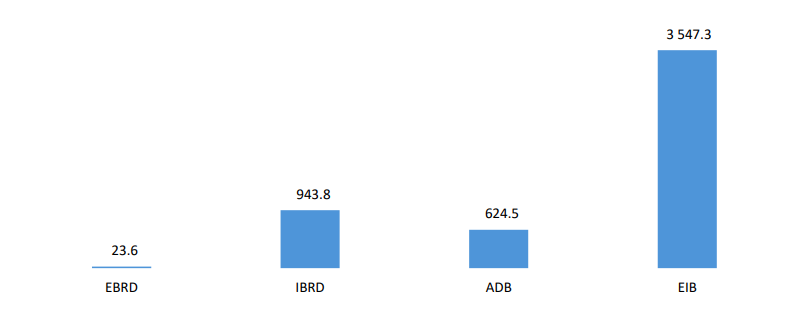
Source: Ministry of Finance of Georgia
The second largest multilateral creditor is the International Bank for Reconstruction and Development. From this financial institution, the Georgian government borrowed approximately 943.8 million GEL between 2015 and 2024 through six agreements. The third-largest creditor, with six agreements concluded between 2015 and 2024, is the Asian Development Bank. During this period, the funds borrowed from the bank amounted to approximately 624.5 million GEL. The remaining two agreements borrowed approximately 23.6 million lari, with the European Bank for Reconstruction and Development as their multilateral creditor.
Graph 7: Loans Received from Multilateral Creditors by Year, GEL Million
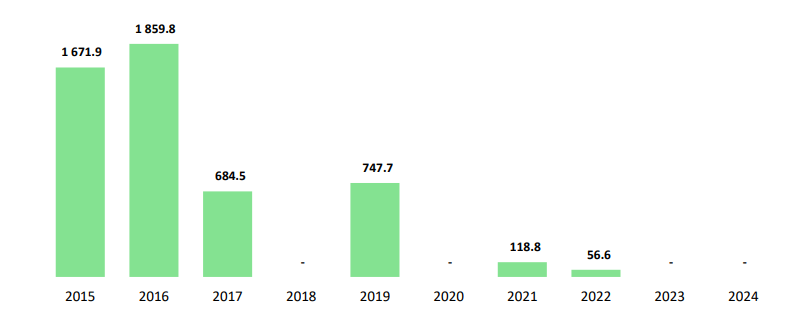
Source: Ministry of Finance of Georgia
Over the last decade, the majority (82%) of funds borrowed from multilateral creditors represent debt taken between 2015 and 2017. In the last two years, specifically in 2023-2024, the Georgian government has not taken loans from multilateral creditors.
III. Summary
Georgia has clearly defined fiscal rules, based on constitutional restrictions imposed on key fiscal parameters. Specifically, ceilings for budget deficit and debt have been established, which has contributed to long-term fiscal stability. Over the years, Georgia has been distinguished by a low consolidated budget deficit, which was reflected in a relatively low level of government debt.
Government debt is mainly composed of financial resources borrowed from external sources. However, in recent years, the share of domestic debt has increased. Domestic debt represents resources raised from local financial institutions through the issuance of securities. External debt includes both bilateral creditors and multilateral financial institutions. The latter dominates the government's external debt. Such creditors include development-oriented banks, whose loans are cheap and long-term financial resources are attracted for implementing large infrastructure projects. The existing debt to multilateral creditors represents money borrowed in earlier years, as no loan agreements with multilateral creditors have been concluded over the last several years.
For the complete document, including relevant sources, links, and explanations, please see the attached file.

